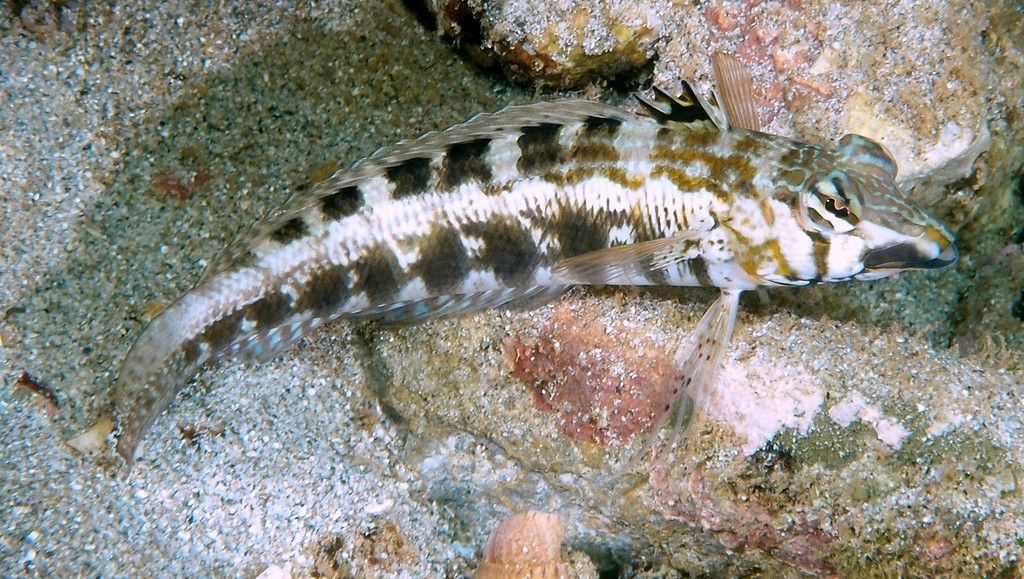PARAPERCIS AUSTRALIS - (RANDALL, 2003)
Actinopterygii (Gigaclass) > Actinopteri (Class) > Teleostei (Subclass) > Labriformes (Order) > Uranoscopoidei (Suborder) > Pinguipedidae (Family) > Parapercis (Genus)
Description
Dorsal spines (total): 5; Dorsal soft rays (total): 20-21 (rarely: 20); Anal spines: 1; Anal soft rays: 17; Pectoral rays: 14-16 (rarely: 14 or 16); Lateral-line scales: 48-59; Gill rakers: 3-4 + 6-8; Predorsal scales: 5-6; Ctenoid scales on cheek; Front of lower jaw with 10 canine teeth; Vomerine teeth in a broad chevron pattern; With palatine teeth; Upper edge of subopercle with a prominent sharp spine; Posterior edge of preopercle sometimes slightly irregular or partially finally serrate; Body depth: 4.35-4.9 in SL (20.5-23.0% SL); Middle dorsal spine longest, 9.5-10.6% SL; Membrane from last dorsal spine joined to base of first soft ray; Slightly rounded caudal fin, 22.9-24.0% SL. Max length: 9.2 cm SL. Depth range: 1-15 m.
Color
A small and elongate bottom dwelling fish with a whitish-grey body, a series of dark brown blotches along the side, and a vertical bar beneath the eye.
Etymology
Parapercis: from Greek prefix, para = resembling to + from Greek, perke = perch. Perch is a common name for fish of the genus Perca, freshwater gamefish belonging to the family Percidae.
australis: named for its southern distribution, south of 14° south latitude.
Original description: Parapercis australis Randall, 2003 - Type locality: One Tree Island, Great Barrrier Reef, Queensland, Australia, depth: 3 meters.
Distribution
Western Central Pacific: Queensland (Australia), Tonga and New Caledonia.
Until Parapercis australis was described (Randall, 2003), this species was previously called as Parapercis cylindrica (Bloch, 1792) in Australia and New Caledonia.
Biology
Inhabits rubble and seagrass areas adjacent to coral reefs, especially in sheltered lagoons. A benthic carnivore feeding on crustaceans, polychaete worms and other invertebrates. The species is a protogynous hermaphrodite, capable of changing sex from female to male. Males maintain a harem-like breeding group of 2 to 10 females per male. Females defend territories from other females, whereas males defend larger areas that encompass the territories of all females in the harem. Males are larger than females and individuals grow rapidly following transition from female to male.
Similar species
Parapercis cylindrica (Bloch, 1792) - Reported from Ryukyu Island Andaman Sea to Micronesia and Samoa - Similar in colour to Parapercis australis with a yellow caudal fin.
Parapercis lineopunctata (Randall, 2003) - Reported from New Caledonia (Chesterfield Islands) - A black line runs from the front of upper lip to eye, sometimes with 1-3 iridescent pale blue lines on snout and cheek below eye. Max length: 7.4 cm SL. Depth range: 3 - 35 m.
Parapercis binotata (Allen & Erdmann, 2017) - Reported from Solomon Islands - Adult with conspicuous black band on rear edge of cheek and short black band on lower pectoral-fin rays; Females with curved black band under eye along lower edge of suborbital.
Perche de sable australe, Australis sandperch, Southern grubfish,
Description
Dorsal spines (total): 5; Dorsal soft rays (total): 20-21 (rarely: 20); Anal spines: 1; Anal soft rays: 17; Pectoral rays: 14-16 (rarely: 14 or 16); Lateral-line scales: 48-59; Gill rakers: 3-4 + 6-8; Predorsal scales: 5-6; Ctenoid scales on cheek; Front of lower jaw with 10 canine teeth; Vomerine teeth in a broad chevron pattern; With palatine teeth; Upper edge of subopercle with a prominent sharp spine; Posterior edge of preopercle sometimes slightly irregular or partially finally serrate; Body depth: 4.35-4.9 in SL (20.5-23.0% SL); Middle dorsal spine longest, 9.5-10.6% SL; Membrane from last dorsal spine joined to base of first soft ray; Slightly rounded caudal fin, 22.9-24.0% SL. Max length: 9.2 cm SL. Depth range: 1-15 m.
Color
A small and elongate bottom dwelling fish with a whitish-grey body, a series of dark brown blotches along the side, and a vertical bar beneath the eye.
Etymology
Parapercis: from Greek prefix, para = resembling to + from Greek, perke = perch. Perch is a common name for fish of the genus Perca, freshwater gamefish belonging to the family Percidae.
australis: named for its southern distribution, south of 14° south latitude.
Original description: Parapercis australis Randall, 2003 - Type locality: One Tree Island, Great Barrrier Reef, Queensland, Australia, depth: 3 meters.
Distribution
Western Central Pacific: Queensland (Australia), Tonga and New Caledonia.
Until Parapercis australis was described (Randall, 2003), this species was previously called as Parapercis cylindrica (Bloch, 1792) in Australia and New Caledonia.
Biology
Inhabits rubble and seagrass areas adjacent to coral reefs, especially in sheltered lagoons. A benthic carnivore feeding on crustaceans, polychaete worms and other invertebrates. The species is a protogynous hermaphrodite, capable of changing sex from female to male. Males maintain a harem-like breeding group of 2 to 10 females per male. Females defend territories from other females, whereas males defend larger areas that encompass the territories of all females in the harem. Males are larger than females and individuals grow rapidly following transition from female to male.
Similar species
Parapercis cylindrica (Bloch, 1792) - Reported from Ryukyu Island Andaman Sea to Micronesia and Samoa - Similar in colour to Parapercis australis with a yellow caudal fin.
Parapercis lineopunctata (Randall, 2003) - Reported from New Caledonia (Chesterfield Islands) - A black line runs from the front of upper lip to eye, sometimes with 1-3 iridescent pale blue lines on snout and cheek below eye. Max length: 7.4 cm SL. Depth range: 3 - 35 m.
Parapercis binotata (Allen & Erdmann, 2017) - Reported from Solomon Islands - Adult with conspicuous black band on rear edge of cheek and short black band on lower pectoral-fin rays; Females with curved black band under eye along lower edge of suborbital.
